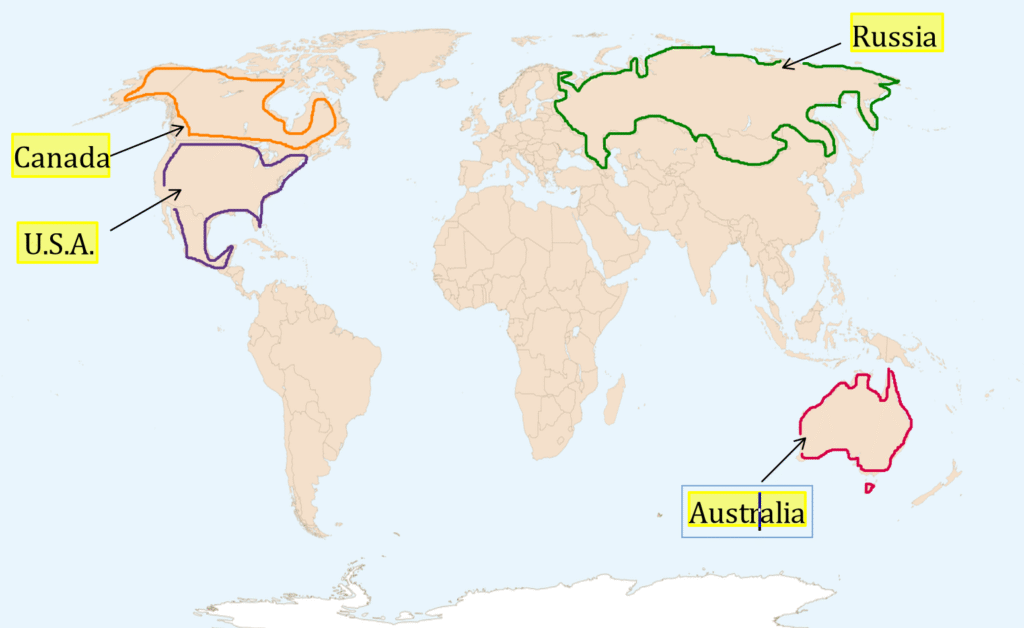These are the NCERT questions and answers from Chapter 2 – Federalism. They are designed to help students understand the main ideas of federalism and learn how to write clear, accurate answers in exams. NCERT questions build a strong foundation for each topic, and practicing them helps you grasp key terms, definitions, and examples. These solutions also guide you in presenting your answers in a simple and effective way, which is important for scoring well. It’s always best to become confident with NCERT questions first, before moving on to additional or higher-level practice.
Questions:-
Q.1 Locate the following States on a blank outline political map of India: Manipur, Sikkim, Chhattisgarh and Goa.
Answer:-

Q.2 Identify and shade three federal countries (other than India) on a blank outline political map of the world.

Q.3 Point out one feature in the practice of federalism in India that is similar to and one feature that is different from that of Belgium.
Answer:-
| Similar Feature | Different Feature |
| Both India and Belgium share power between the central and regional governments to maintain unity and accommodate diversity. | Belgium gives equal powers to both language-based communities and regions, while India mainly shares power between different levels of government, not communities. |
Q.4 What is the main difference between a federal form of government and a unitary one? Explain with an example.
Answer:-
| Federal form of government | Unitary form of government |
| A federal government divides power between the centre and states. | While a unitary government gives all key powers to the central authority. |
| For example, in India, both the Union and State Governments have their own powers mentioned in the Constitution. | For example, in the UK, Parliament holds all powers, and local governments act under its control. |
Q.5 State any two differences between the local government before and after the Constitutional amendment in 1992.
Answer:-
| Before Constitutional amendment in 1992 | After Constitutional amendment in 1992 |
| Local governments were not regular or powerful. States could choose whether to hold local elections or not. | The Constitution made it mandatory to hold regular elections for local bodies every five years. |
| local bodies had limited powers and often lacked funds. | Local bodies got more powers, a clear structure, and a share in state government revenue. |
Q.6 Fill in the blanks.
Since the United States is a coming together type of federation, all the constituent States have equal powers and States are strong vis-à-vis the federal government. But India is a holding together type of federation and some States have more power than others. In India, the central government has more powers.
Q.8 The distinguishing feature of a federal government is:
(a) National government gives some powers to the provincial governments.
(b) Power is distributed among the legislature, executive and judiciary.
(c) Elected officials exercise supreme power in the government.
(d) Governmental power is divided between different levels of government.
Answer:- (d) Governmental power is divided between different levels of government.
Q.9 A few subjects in various Lists of the Indian Constitution are given here. Group them under the Union, State and Concurrent Lists as provided in the table below.
A. Defence; B. Police; C. Agriculture; D. Education;
E. Banking; F. Forests; G. Communications; H. Trade; I. Marriages
Answer:-
Union List : Defence, Banking, Communication
State List : Police, Agriculture
Concurrent List : Education, forest, trade, marriages.
Q.10 Examine the following pairs that give the level of government in India and the powers of the government at that level to make laws on the subjects mentioned against each. Which of the following pairs is not correctly matched?
(a) State government : State List
(b) Central government : Union List
(c) Central and State governments : Concurrent List
(d) Local governments : Residuary powers
Answer:- (d) Local governments : Residuary powers
Q.11 Match List I with List II and select the correct answer using the codes given below the lists:
| List I | List II |
|---|---|
| 1. Union of India | A. Prime Minister |
| 2. State | B. Sarpanch |
| 3. Municipal Corporation | C. Governor |
| 4. Gram Panchayat | D. Mayor |
(a) D, A, B, C
(b) B, C, D, A
(c) A, C, D, B
(d) C, D, A, B
Answer:- (c) A, C, D, B
Q.12 Consider the following statements:
A. In a federation, the powers of the federal and provincial governments are clearly demarcated.
B. India is a federation because the powers of the Union and State Governments are specified in the Constitution and they have exclusive jurisdiction on their respective subjects.
C. Sri Lanka is a federation because the country is divided into provinces.
D. India is no longer a federation because some powers of the States have been devolved to the local government bodies.
Which of the statements given above are correct?
(a) A, B and C
(b) A, C and D
(c) A and B only
(d) B and C only
Answer:- (c) A and B only
Here are some other links related to this chapter.

